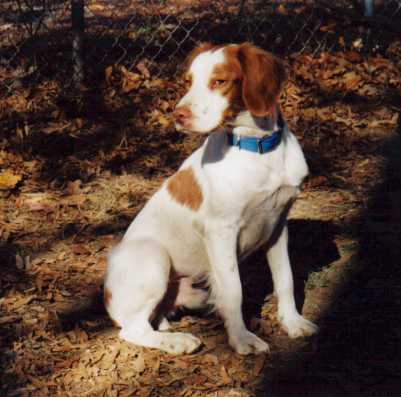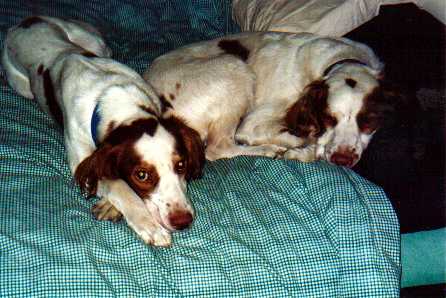Bird Dogs...
Quail...
Resources...
Library...
Dog Training Collars
Tri-Tronics
SportDog
Dogtra
Innotek
A Diamond in the Rough
Part II: Early socialization issues

Socialization is a term that is now a fundamental piece of any dog trainer's vocabulary. With the bevy of books now available on the subject, there is no excuse for the modern dog trainer to be unaware of the role that this interaction plays in turning a pup into a bona fide bird dog. You may find a few old trainers who insist that they never used anything called "socialization" when training their dogs, and they may be telling you the truth. Chances are they never did so intentionally, but if you phrase the question just right, you'll likely find out that they spent a whole lot of time just hanging around with their dogs. Walking, chasing, wrestling, scratching, and any other form of play that is not formal training falls under the heading "socialization".
In the introduction to this series of articles, I provided the background of JJ, a year and a half old Brittany acquired through a rescue program. JJ spent the first year and a half of his life chained up in the woods, visited once a day by someone who fed him and occasionally fired a shotgun over his head. Other than this brief, unemotional visit, he had no human contact. In short, he was not socialized.
There is no real science to socializing a pup. It is simply a matter of spending time with him, the goal being to build trust, instill a desire to be with a human, and establish that time spent with a human can be a whole lot of fun. A dog who wants to be with you is infinitely easier to train than a dog who would rather not have you around. So before I could undertake any true training with JJ, I had to get him to the point that he had a morsel of trust in me.
State of Affairs
When our relationship began, JJ responded to me as he responded to everyone else: he either barked at me or kept at a safe distance. If I ignored him, he would eventually move within arm's reach, but as soon as I paid any attention to him, he would retreat. Stanley Coren describes this condition in his book The Intelligence of Dogs:
"…domestic dogs have been bred to reduce their neophobia, or fear of new and unfamiliar things and people. Such fear is quite common in wild canids, and it is not easy to eliminate. In domestic dogs, it is considered an undesirable trait. We refer to neophobic animals as anxious, fearful or apprehensive and describe them with terms such as "touch-shy" or "spooky"."
Despite being bred a domestic animal, JJ could safely be described as neophobic. Lack of socialization allowed some of the "wild" tendencies to surface, resulting in an animal who shied away from human contact. Though never nervous to the point of trembling, his lack of comfort around people manifested itself in several obvious ways. Strangers entering a room frequently sent him running and barking into another room, trailing droppings in the process. JJ was so apprehensive around me that he would not take treats or food scraps from my hand. He frequently stood in the doorway just outside of a room that was occupied by people, looking in on the activities but never entering. He rarely lay down on the floor and always seemed to be on guard. And he barked. At everything. Wonderful if you want a watchdog, annoying if you want a pet.
Methods
Because of his flighty tendencies, I did not let JJ into the yard unless he was on a check cord. Getting him on this check cord was rarely a quick process and usually required me to sit somewhere in the house, check cord in my lap, and pretend to ignore JJ for five minutes or so until he came to me on his own. If I moved slowly, I could get a hand on his collar and then attach the check cord; if I moved too quickly, we had to start the process all over again. Lesson: If you are not a patient person, this type of project should probably be avoided.
Most dogs need a place that they can call their own, a place where they feel secure and content. At night and while I was at work, I kept JJ in a kennel inside the house. When led to the kennel, he willingly entered it and once inside, he never whined or cried, which indicated to me that he was content. Getting him to the kennel necessitated another round of the check cord ploy, but once he was near the kennel, he trotted on in. I had to clean up far fewer accidents and we both got many more hours of sleep because of this little plastic hideaway.
Having grown up outdoors, JJ did not understand that there are certain places that he should not relieve himself. Fortunately for both of us, the housebreaking process proved much easier than I anticipated. A key to this was establishing a routine. Whenever I let JJ out of his kennel, I immediately turned him outside. While I was at home and he was loose in the house, I let him outside about once an hour. Of course there were accidents, but I never scolded him. With a dog like JJ, scolding would have been quite detrimental. Instead, I cleaned up the mess, treated the spot with a spray to remove the smell and thus reduce his tendency to use the same spot again, and moved on.
Several other techniques contributed to easing the socialization process. Every time I leaned over to scratch or pet him, he instinctively lowered his head, so I made it a point to always place my hand under his chin, gently raise his head, and then scratch his chin- never the top of his head. Whenever possible, I would sit or lie on the floor. He seemed much more comfortable entering a room when I was on the floor than when I was seated in a chair or standing. I avoided making sudden movements. And most importantly, I consistently rejected the urge to yell at or scold him.

|
One final item worth mentioning while on the subject of methods is the contribution made by my other dog, Curtis. From the start, JJ and Curtis got along like littermates, despite their 3 ½ year age difference. On a daily basis, Curtis gave cues to JJ about how to interact with humans. I have no doubt that this process would have been much, much more difficult without the benefit of a socialized dog.
Measures
Lacking a standard system for measuring a dog's level of socialization, I decided to track my progress using three milestones:
- JJ wagging his tail in response to some action on my part
- JJ rolling over on his back and baring his stomach
- JJ coming to me when called
Tail wagging is an involuntary reaction by dogs when they are happy and at ease. Rolling over and baring the stomach is generally considered to be a sign of submission and acceptance. Coming when called indicates both a desire to be with me and a modicum of trust in me. He did none of these at our first meeting.
Current Status
Initially, I intended to give a detailed timeline of our progress, noting dates when significant milestones occurred and documenting the periods between them. After thinking it through, however, I decided that this would serve more bad interests than good. Each dog learns at his own rate, and comparing your dog's progress to JJ's progress would be an exercise with little value. It might serve to either frustrate or encourage you unnecessarily.
As I write, JJ now regularly wags his tail in response to my attentions. He rolls over on his back when I scratch him, and with a few exceptions, he comes when I call him. Above and beyond those three measures, he now roams the house with little concern over the occupants of a room, he enters rooms with only one doorway, he lies down on the floor in occupied rooms, he rarely barks at me, and he sleeps in the bed with me at night. He is housetrained and during the day, he stays in the yard with Curtis, unrestrained. Most of the everyday sounds that used to send him into a barking frenzy (doors, icemakers, cars, coughs, sniffles, sneezes, neighborhood voices) are now met with indifference.
I don't want to give the impression that JJ has undergone some sort of metamorphosis and is now an outgoing, gregarious animal. He is still quite shy around strangers and still lapses into his former personality when the going gets tough. But he has made great strides and is now at a point, socialization-wise, that he can begin some rudimentary obedience training, which is what the next article in the series will address. In closing, I would like to note the three most important things I have learned in dealing with an abused, unsocialized animal:
- Patience is not only a virtue, it is a necessity.
- Establishing some sort of routine should be a priority.
- Yelling, scolding, and spanking should be avoided at all costs.
Diamond in the Rough series
 Windows users press "CTRL+P" to print this page
Windows users press "CTRL+P" to print this page  Mac users press "Apple/Loop+P" to print this page
Mac users press "Apple/Loop+P" to print this page